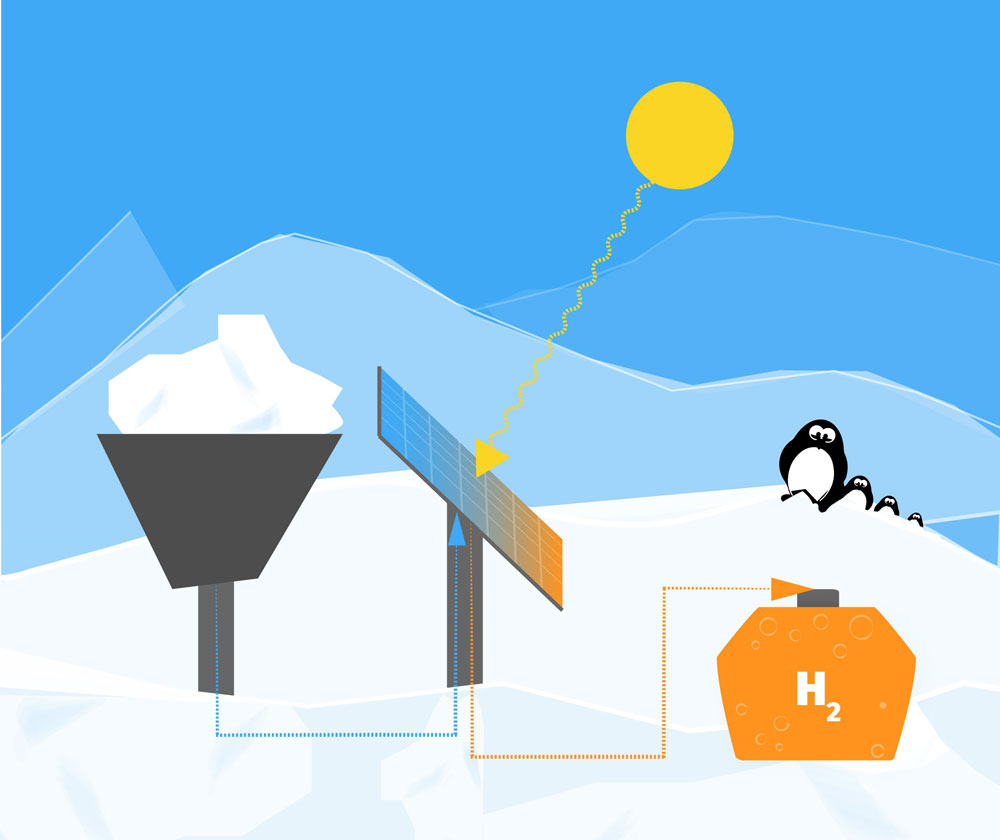Green Power for Antarctica: Solar Hydrogen as an Alternative to Oil?
Could "solar hydrogen" produced from sunlight serve as energy alternative to oil in the Antarctic? A feasibility study by HZB experts in artificial photosynthesis within the "Experiment!" funding initiative. Next deadline for applications for "Experiment!": July 10, 2019
Apart from penguins, it is mostly researchers that live in Antarctica – collecting neutrinos, analysing glaciers and ice cores, and investigating how organisms survive the hostile conditions. Many research stations are operated year round and require heat and electricity, a large part of which is generated from crude oil.
Elaborate and Risky: Energy Supply With Oil
Environmental physicist Dr. Kira Rehfeld from Heidelberg University noticed how costly and laborious the transportation of crude oil to this region of the world is, however, when she took part in an Antarctic expedition. Even the smallest leaks are an enormous problem for the sensitive ecosystem, which is why strict precautions must be observed during transport.
Hydrogen as Storage for Solar Energy
At the same time, the sun in Antarctica shines around the clock during the summer months and is very intense. Could it be possible to convert this solar energy into a form of energy that can be easily stored? Rehfeld played through this idea together with Dr. Matthias May (Helmholz Zentrum Berlin, HZB) when she returned home. May is researching complex material systems that use sunlight to split water molecules into oxygen and hydrogen. The hydrogen molecules store the energy from light as chemical energy. This chemical energy can in turn be converted into electrical power (electricity) or heat, with the hydrogen being converted back to just water with no harmful emissions. And a crucial point: hydrogen gas can be compressed and stored in tanks, so that the hydrogen stored in summer is available in the winter time as well when there is no sunlight.
Rehfeld and May developed a project outline that they submitted to the Volkswagen Foundation under the Foundation’s "Experiment!" programme. The project is now being funded for 18 months with a grant of 120,000 euros. May and Rehfeld will carry out a feasibility study during this period.
Antarctic Challenge
The researchers will have to develop approaches for solving a number of problems: splitting water with solar energy requires that photovoltaic thin-film semiconductors be combined with electrochemical reactions. However, while photovoltaic converters work quite well even at temperatures below zero, chemical reactions take place very slowly when it is cold. Moreover, modules for the production of hydrogen from sunlight must operate autonomously and be largely maintenance-free. However, the initial solutions do not necessarily have to be particularly inexpensive. “The rise of photovoltaics also began with solar cells that were initially very expensive and could only be used in satellites”, argues May. ”Supplying the Antarctic stations with crude oil is also extremely expensive and in addition involves high risks to the environment. It is definitely worthwhile to think about alternatives“, stresses Rehfeld.
Background: The "Experiment!" Funding Initiative
The "Experiment!" initiative addresses researchers in science and engineering as well as in the life sciences, who want to put a potentially transformative and risky research idea to the test. They are given the opportunity to demonstrate preliminary evidence for a concept’s potential during an exploratory phase which is limited to 18 months and up to 120,000 Euro. A short sketch is sufficient as an application, the funded projects are selected via a partly randomized procedure. For more information on the funding initiative, please see "Experiment!". Next deadline for applications is July 10, 2019.

